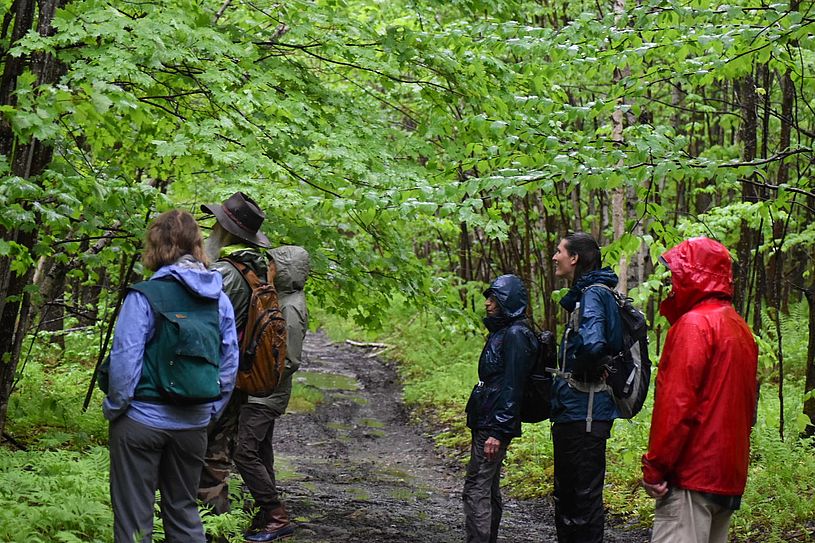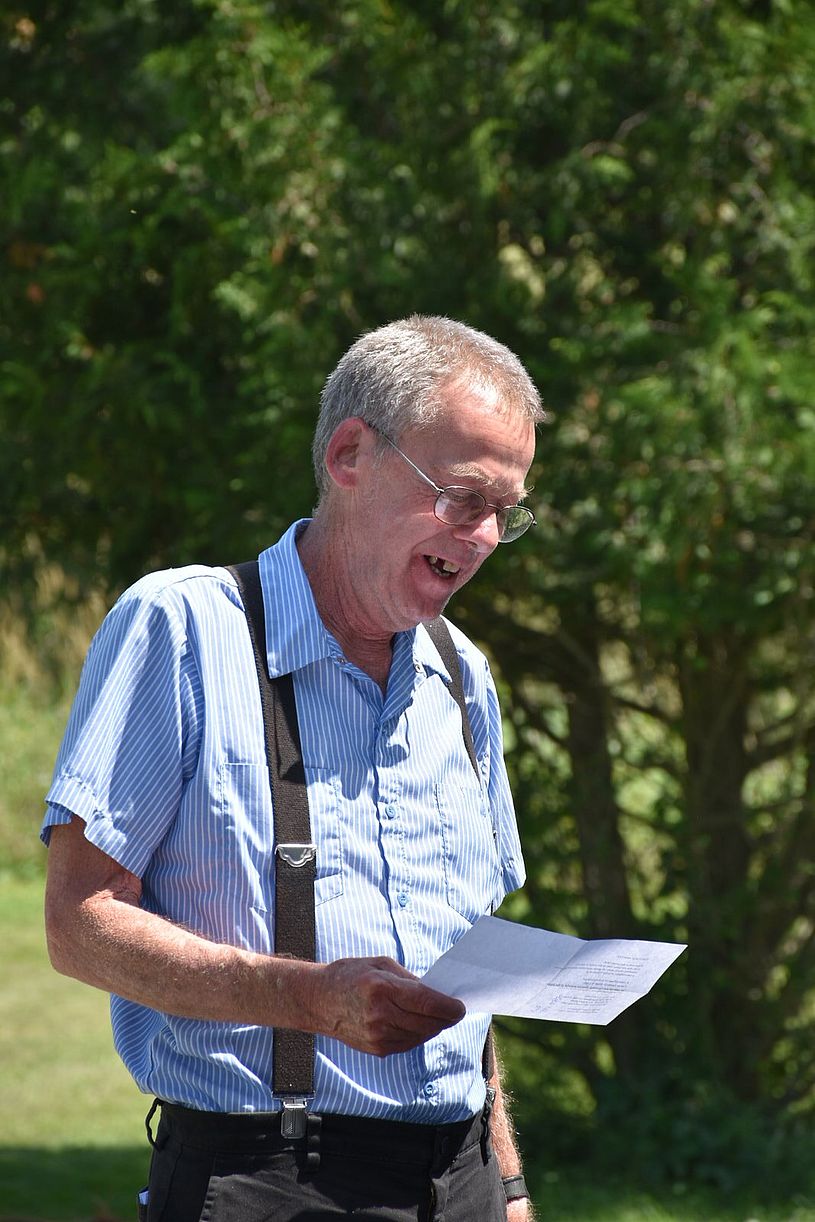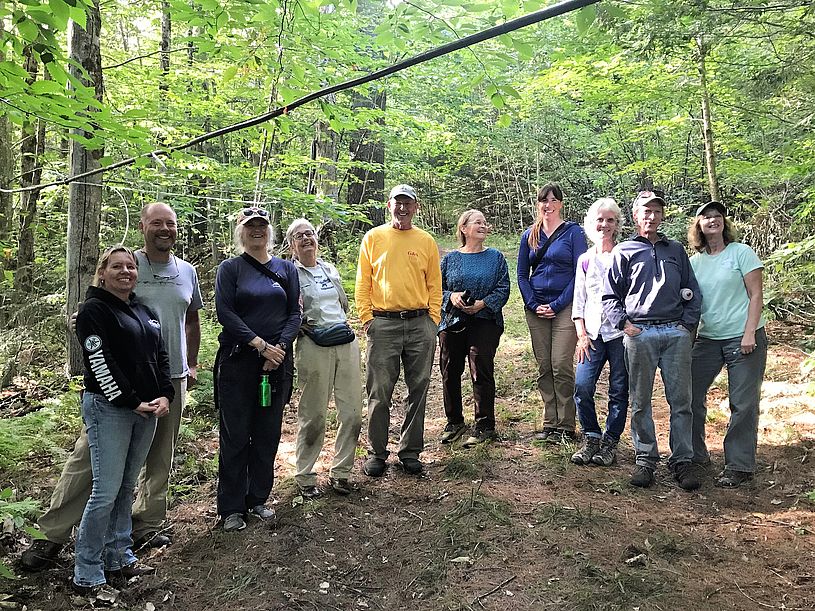The Landowners
Ultimately, the Woodlots Program is for the landowners, so substantial thought should be given to who your intended audience is and what will bring landowners together in your region. If there is nothing to entice landowners to be part of the program, there won’t be a program!

How Many?
We have found that having the owners of 10-20 parcels in a single program works well. Remember that not everyone will attend every time–but occasionally nearly everyone will! While it’s tempting to build your numbers up to an even greater number, it’s also important to remember that the landowners themselves host these gatherings, and the program works because a group of individuals is building a community.
When a program drops below 10 parcels:
- This can be hard on hosts, because the frequency in which we ask each individual to host goes up. This can be stressful for some.
- We don’t feel as comfortable inviting guest speakers. If they are volunteering, it is hard to justify their time. If we are paying, it’s hard to justify the cost.
- Landowners start feeling like they’ve had the same excursions before, since they’re visiting the same locations.
When a program rises above 20 parcels:
- This can be hard on hosts. Parking is a problem. Some may not have appropriate indoor spaces. Potlucks become difficult.
- There is less of a feeling of community. Participants can’t get to know everyone in the same way, and they start to form sub-groups within the larger group rather than feeling like a cohesive unit.
- Some excursions become so large that discussion is difficult. When examining wildlife tracks, for example, not everyone can gather around the point of interest at one time, so only part of the audience hears what the leader is saying.
- If you are offering resources such as Forest Bird habitat Assessments or Climate Change Analyses, consider how many can be accomplished in a single season. If you need to stretch these into several years, you may lose some of the group cohesion. Size matters when gauging capacity to offer these resources, too.

Who’s Invited?
At Cold Hollow to Canada, Woodlots participation is by invitation only. This is not intended to be exclusive; rather, it is a measure that allows participants to feel safe and trust one another. They know what to expect when hosting and attending programs, because they know who is likely to show up.
In your community, you will want to think carefully about what parameters to put in place when drafting your invitation list. At Cold Hollow to Canada, we make great efforts to get to know people in our small community before initiating programs. Building trust is key to the success of the programs, so we want to start knowing that an initial group of participants will do well together. A group can always expand from there.
We started with a map of the most important forest blocks for stewardship and conservation in our region. We then looked at the parcels that would be most crucial, following our list of ranking criteria (see the “Program Requirements’ section below). Because we have personal connections in these communities, one final check is: Will others in the group feel safe talking about stewardship and conservation in the presence of this individual? Even if a parcel is a key link in the ecological or landscape context, a landowner who we think will be disruptive to the group or be argumentative in response to the conservation and climate change-based subject matter may not be invited to participate. Because we feel that building trust and community within these groups is crucial to their success, we take efforts to find ways to maintain this.
It’s worth noting that in all honesty, the process is fairly self-selecting. An individual who doesn’t agree with the content of the group is unlikely to attend even if invited, and if an individual asks to participate, he/she is usually a good candidate for the program (if other requirements like parcel size and location are met). To date, the invitation process has not been a source of conflict.
This means that the programs are not publicly advertised. When members identify a neighbor who they think would be a good match for the program, the participant proposing the addition will often invite them to a program that he/she hosts. If that session goes well, the participant is invited to join. You may consider having a more formal “application” process. However, we have found that casual is often best. We don’t want to intimidate our participants or make them feel that they are committing to something too rigorous. We want them to continue participating because they are interested in participating, not out of obligation!
Program Personality
It’s also important that landowners bring themselves to the program. They are the most important resources present, and each has something to offer the group that will contribute to the overall feeling of community. For example, a landowner in one CHC group is a writer and poet. Over time, this group has evolved a tradition to end each gathering with a poem. We would never have thought to include this in the programming, but it is now a cherished part of each meeting, connects people to one another, and builds a beautiful feeling of community. Your group will undoubtably have different skills and personalities--and a unique flavor!
For Anna by Geof Hewitt
Your father lectures you on canoe safety.
He says the slightest shift
can fill the boat with water, so be still.
And having sat you safely in the center
Of its floor, he lets himself in
Talking all the time—now notice how I keep
Weight low and to the center, he preaches
As the side goes under and he swamps it.
In these thin waters, a seasonal marsh that comes to life each spring with peepers,
There is little danger of drowning as long as one
Doesn’t try to swim but stands in the knee-deepest parts.
And he does and so do you, both sputtering.
After helping him beach and empty the canoe,
With the wisdom and trust of a child
you insist that he be first, then board his boat again.
Reprinted with permission from The Perfect Heart: Select and New Poems , Mayapple Press 2010
Some have suggested that we may be “preaching to the choir.” In a rural community, however, the topics discussed in Woodlots often don’t have a place in public discussion. We believe we are identifying community members who have expressed an interest in joining a choir--and we create one! We then provide the framework that supports their collective "singing."

Photo by Liza Morse
Engagement: How does it work?
Program requirements
In this program, landowners are invited to join. The CHC board makes the decisions about who to invite, with input from existing group members. Guidelines include:
- Ownership or stewardship of a forested parcel at least 50 acres in size, within core habitat or connecting blocks in the program's geography. Size exceptions can be made if the parcel is in a location of particular concern.
- Have a forest management plan (or willingness to create one)
- Willingness to occasionally host a gathering by showing land and stewardship techniques to others within the group
- Eagerness to learn about sustainable forest management strategies, climate change resilience, natural history, and other forest stewardship topics
- Attend at least one event per year
Why do landowners engage?
Landowners have told us that they engage because:
- They enjoy it! (The potlucks are often called out in particular!)
- They feel that they've become better land stewards who are better equipped to make management decisions. They learn from experts and from each other.
- They better understand what resources are available to them.
- The financial incentives definitely help.
- They get to know their neighbors in a new way by connecting over their shared land stewardship experiences.
- They see how their land fits into a bigger picture.
There are also a number of “tools” we use to give back to landowners. (Not all tools are available to all landowners.) See more on the Programming page!
- Audubon Vermont Partnership: Songbird Habitat Assessments (These are very popular.)
- Northern Institute of Applied Climate Science’s Climate Change Analyses
- The Natural Resources Conservation Service’s Regional Conservation Partnership Program
- Carbon Aggregation Project
- Conservation Fund to help with land conservation expenses
- Community-wide activities (community science projects, outreach, aid with municipal planning and conservation work, etc.)
- Engagement with opportunities offered by partners (Birder Broker, Coyote Stories, etc.)
In general, about 50% of the landowners invited to join a program end up participating.

Building Relationships, Building Trust
It is CHC’s belief that it is crucial to build relationships and trust before beginning a Woodlots program. Indeed, the founding members of the organization have been building relationships formally since 2007 when the organization began, and some board members have relationships spanning their entire lives. By the time the Woodots Program began, most landowners had already interacted with CHC or its individual board members numerous times before receiving their invitation letters. While they may not have known exactly what the program would be about, they knew these were individuals and an organization that they wanted to engage with.
This idea was reinforced when, in 2020, CHC made plans to establish a program in a set of towns where we had done little programming or relationship-building in the past. These communities were not as familiar to us.
Before starting the programs, we reached out to a few allies that we did have in the communities–and we were glad we did. While our programs have been very popular and welcome in other locations, our allies in these towns warned us NOT to start programs there. The communities don’t know CHC, they said. They feared that by reaching out to a small subset of the population (landowners with more than 50 acres of forestland), we may actually turn the greater communities off, appearing to be an exclusive club rather than a welcoming organization. This was certainly not our intention. We changed plans, delayed our program, and started with a series of outreach opportunities. These had overwhelming turnout, and they allowed us to get to know the communities–and for the communities to get to know us. We connected with the Planning Commissions in both communities, got feedback on our programs from citizens, and generally feel like we’ve become “friends” who can support each other where our goals overlap. We’re now feeling ready to start a Woodlots program, and now it feels like just one tool we’re using to help the community move forward–instead of feeling like an exclusive opportunity available only to a few people.

